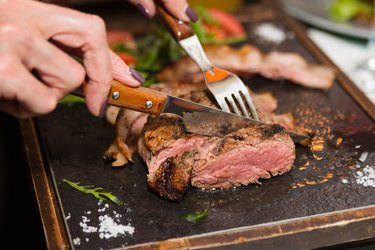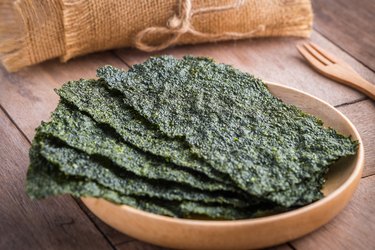
Arachidonic acid is an essential fatty acid, but it doesn't get as much positive publicity as some of the other omega-3 and omega-6 fats.
Arachidonic acid is one of four omega-6 fatty acids that we get through our diets: The others include linoleic acid, gamma-linoleic and conjugated linoleic acid. Some foods high in linoleic acid include nuts, seeds and some refined vegetable oils.
Video of the Day
Video of the Day
Arachidonic acid is a conditionally essential nutrient because our bodies can produce it on its own when we eat linoleic acids, per a May 2018 review in the Journal of Advanced Research. Arachidonic acid is found in cells all over the body and supports the nervous, skeletal and immune systems.
While our body needs arachidonic acid, it also plays a key role in the development of diseases like heart disease, cancer and inflammatory condition like arthritis and asthma, according to a February 2021 review in Nature.
Arachidonic acid is a key component of the inflammatory process and is the precursor to several inflammatory molecules. It also plays a part in the activation of anti-inflammatory molecules to regulate inflammation, according to the Linus Pauling Institute.
Claiming that arachidonic acid is only inflammatory may be too simple and not explain the whole picture of this fatty acid's role.
1. Sardines
Sardines have one of the highest amounts of arachidonic acid, per an April 2019 study in Lipids in Health and Disease.
While the little fish may be high in arachidonic acid, it's also high in heart-healthy omega-3s. The high levels of omega-3s in sardines and other fatty fish may counteract the inflammatory effects of arachidonic acid, per an August 2015 review in BioMed Research International.
2. Salmon
Salmon may be best known as a food high in omega-3s, but it also contains arachidonic acid. The amount is based on what the fish eats and whether it's farmed or wild. The omega-6 to omega-3 ratio was found to be higher in farmed salmon than wild-caught salmon in a small December 2020 study in the journal Foods.
Does Fish Oil Contain Arachidonic Acid?
Fish oil supplements often advertise only DHA and EPA as their active ingredients. Small amounts of arachidonic acid were found in three fish oil supplement samples, ranging from 0.78 to 2.56 milligrams of arachidonic acid per 100 grams of fish oil, according to an August 2021 study in Molecules.
3. Eggs

Even if you're not eating eggs over-easy every day, they could still be contributing to your overall arachidonic acid intake.
One study found that 30 percent of people's arachidonic acid intake came from eggs — not because they ate an omelet every morning, but because eggs are an ingredient in so many different foods, according to December 2009 research in The Journal of Nutrition.
4. Chicken
Chicken and other types of poultry contain arachidonic acid. A 3-ounce portion of lean chicken breast contains 27 grams of protein and only 2.8 grams of fat. Most of the fat in chicken is unsaturated.
Replacing meats that are higher in saturated fat with chicken can help lower overall saturated fat intake while increasing unsaturated fats. The American Heart Association recommends reducing saturated fat to less than 6 percent of total daily calories for people working to lower their cholesterol.
5. Pork
Like other sources of meat, pork fat and lean meat is a source of arachidonic acid. A 3-ounce serving of pork loin is also an excellent source of several B vitamins including thiamin, riboflavin, niacin and B12.
B vitamins are important in the formation of red blood cells and for turning the food you eat into energy, according to the U.S National Library of Medicine.
6. Beef
The time of year your beef was finished could make a difference in the amount of arachidonic acid it contains. Researchers found that the beef finished in the spring had significantly higher amounts of arachidonic acid than those finished in the fall, per a February 2020 study in PLOS One.
7. Milk
Milk and milk products contain arachidonic acid in different amounts. Between 10.5 percent and 18.8 percent of the omega-6 fatty acids we eat come from arachidonic acid in milk fat, per a July 2013 study in the Journal of Dairy Science.
Milk can be a good source of vitamin D, but not always if you're buying a plant-based milk alternative. Always make sure to check the nutrition facts label for added vitamin D.
8. Seaweed

Seaweed is the only significant plant source of arachidonic acid. This means that while vegans and vegetarians who avoid dairy and eggs can make their own arachidonic acid through linoleic acid, they can also get a direct source through seaweed products.
Red and brown seaweed contains arachidonic acid but green seaweed doesn't, per a June 2011 study in Lipids and Health in Disease. Kelp and Kombu are popular brown seaweed varieties, while Nori and Dulse are a part of the red seaweed family.
How Can Vegans Get Arachidonic Acid?
People who follow a vegetarian diet are still able to get arachidonic acid through dairy or eggs if they choose to eat these foods. People on a vegan diet, or vegetarians who do not eat dairy or eggs, must rely on plant foods that contain linoleic acid that can then be converted into arachidonic acid.
Vegetable oil, nuts, and seeds are vegan sources of linoleic acid.
- Journal of Advanced Research: "Arachidonic acid: Physiological roles and potential health benefits – A review"
- Nature: "Metabolism pathways of arachidonic acids: mechanisms and potential therapeutic targets"
- Linus Pauling Institute at Oregon State University:"Essential Fatty Acids"
- USDA: "Lean Chicken Breast"
- American Heart Association: "The Skinny on Fats"
- USDA: "Lean Pork Loin"
- US National Library of Medicine:"B Vitamins"
- PLOS One: "Seasonal differences exist in the polyunsaturated fatty acid, mineral and antioxidant content of U.S. grass-finished beef"
- The Journal of Nutrition: "Dietary Arachidonic Acid to EPA and DHA Balance Is Increased among Canadian Pregnant Women with Low Fish Intake"
- Foods: "An Update on the Content of Fatty Acids, Dioxins, PCBs and Heavy Metals in Farmed, Escaped and Wild Atlantic Salmon (Salmo salar L.) in Norway"
- Molecules: "Quality of Fish-Oil-Based Dietary Supplements Available on the Italian Market: A Preliminary Study"
- Lipids in Health and Disease: "Intake of arachidonic acid-containing lipids in adult humans: dietary surveys and clinical trials"
- Biomed Research International: "ω-3 PUFAs in the Prevention and Cure of Inflammatory, Degenerative, and Neoplastic Diseases 2014"
- Journal of Dairy Science: "Concentrations of n-3 and n-6 fatty acids in Dutch bovine milk fat and their contribution to human dietary intake"
- FDA: "Vitamin D for Milk and Milk Alternatives"
- Lipids in Health and Disease: "Polyunsaturated fatty acids in various macroalgal species from north Atlantic and tropical seas"